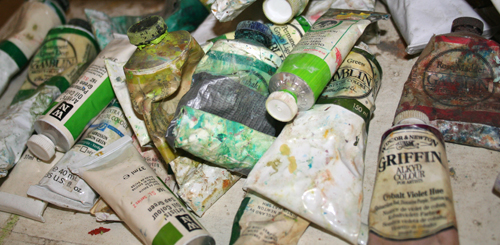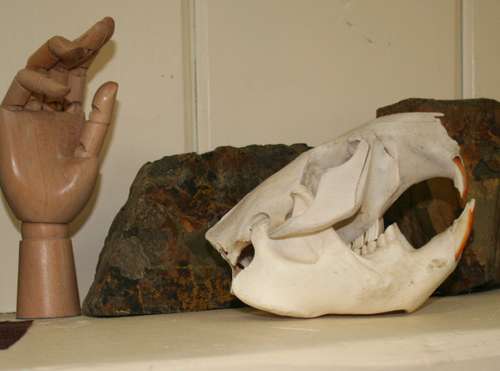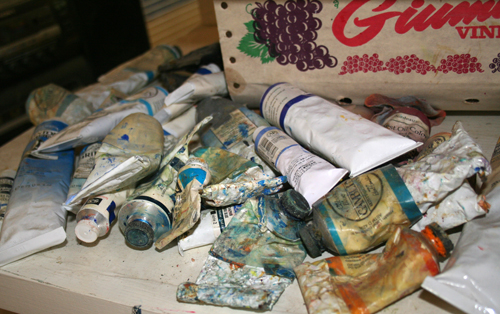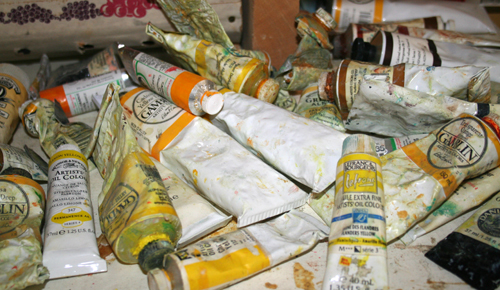

__________________________________________________________________________________________
Home
FAQ Contact
Collecting
Events Workshops
Bio
Press
__________________________________________________________________________________________
|
|




|
I don't think of it as "still life." I was painting my glasses for a quite a while before someone used that term with me. I was rather stunned. I think of "still life" as something more traditional with a narrative. These paintings are more contemporary. Spatially, there is movement and depth, "abstraction" and "realism" combined. They seem anything but still. With the exception of some of the Night Oils, they certainly aren't traditional still life. It's kind of like when the painter Barnett Newman was talking about Cezanne and he said something like, "He could've been painting cannonballs or oranges!" In other words, it wasn't about the fruit. While we associate fruit with "still life," it was about the shapes of the objects and what he was trying to achieve with them in space - abstracting it. It's a great vehicle for me to explore the dynamics of space: flattened abstraction, reeling distortion through refraction, a line or a plane rushing backward in space. I like the combination of hard surface and liquid movement. It's like a dance of light. It's clear the spatial shifts and luminous colors speak to others as well. Innumerable times I've watched people stop before my glass paintings and get lost in the looking. You can see the muscle tension ebb out of them. It looks like it lowers their blood pressure. This can only be a good thing. It's one of the reasons art exists, to get us outside ourselves and experience something unexpected. Do you work from real life or photographs? I work from observation. I set up the objects the way I want on top of a pedestal I've made of stacked 5 gallon paint buckets - pretty high-tech. I need to be able to respond to the real thing, the way the light bounces off surfaces, the luminosity of the shadows, the reflected light. Working from photographs may work great for other people, everyone has their own way of working, but for me it feels lifeless. The only exception to this has been recently with my ice cream paintings. It turns out, whipped cream pretty much self-destructs under halogens! I resort to building a sundae twice, once to paint the bottom half, and again to paint the top half. If it still is falling apart too fast, I will sometimes resort to taking a photo for last-touch consultation. Do you use fluorescent paint? I've been asked this before. I guess it's in response to the way my color glows. I absolutely love color. It really affects my quality of life. It's all about color relationships. It isn't a certain kind, or brand, of paint. Color affects color... in everything, not just paintings. How color looks is completely dependent on what is next to it or near it. You can make color that seems to create its own light. Likewise, you can kill a painting by adding the wrong color. This is why I'm not a fast painter. It requires experimentation. If I lay on a color and it doesn't "add to the plot", I take it off and try again. How do you know when someone really likes a painting? Sometimes it seems I know before they do. When I see someone get lost in a painting, losing track of time. When people come back to visit a painting multiple times at a show, that's a pretty clear indicator it speaks to them and would enhance their quality of life. Our society tells us the arts are superfluous. I think the opposite. I think, like nature, the arts balance us. They help us give voice to the things that matter most. An enriching piece of art, or a day spent in nature, renews us and helps us find our better selves. It helps us rise to the occasion and do all that crazy stuff that life demands of us. What advice would you give to someone starting out in, or returning to, art after a long hiatus? Cut yourself slack. Do ten paintings or drawings before you begin to judge. I've seen so many people, including myself, start off with unrealistic expectations. People think it's got to do with talent and whether or not you're "good." Sure, some people are born with gifts that others do not have. But it's more rare than you think. What most people refer to as "Talent" really is just a lot of long hard hours, years, spent working in isolation - challenging yourself to do better. It's the old saw: writers write; painters paint. No way around it. There's no magic bullet. The other thing I remember was the rush to find all the answers, figuring it would be easier then. The truth is, you never have all the answers. In art, or anything! The trick is to learn to enjoy the process of discovery. I think if you have all the answers, you've begun to congeal. You've stopped trying new things. The wonderful thing about art is you never get to the end of learning. In the beginning, that's frustrating. Later, it's the fun of the ride. I think of Matisse, working from his bed at 86. Still trying new things. Still making discoveries that changed how we see the world and art.
|
Copyright
2009-2010 Kit Night All rights reserved